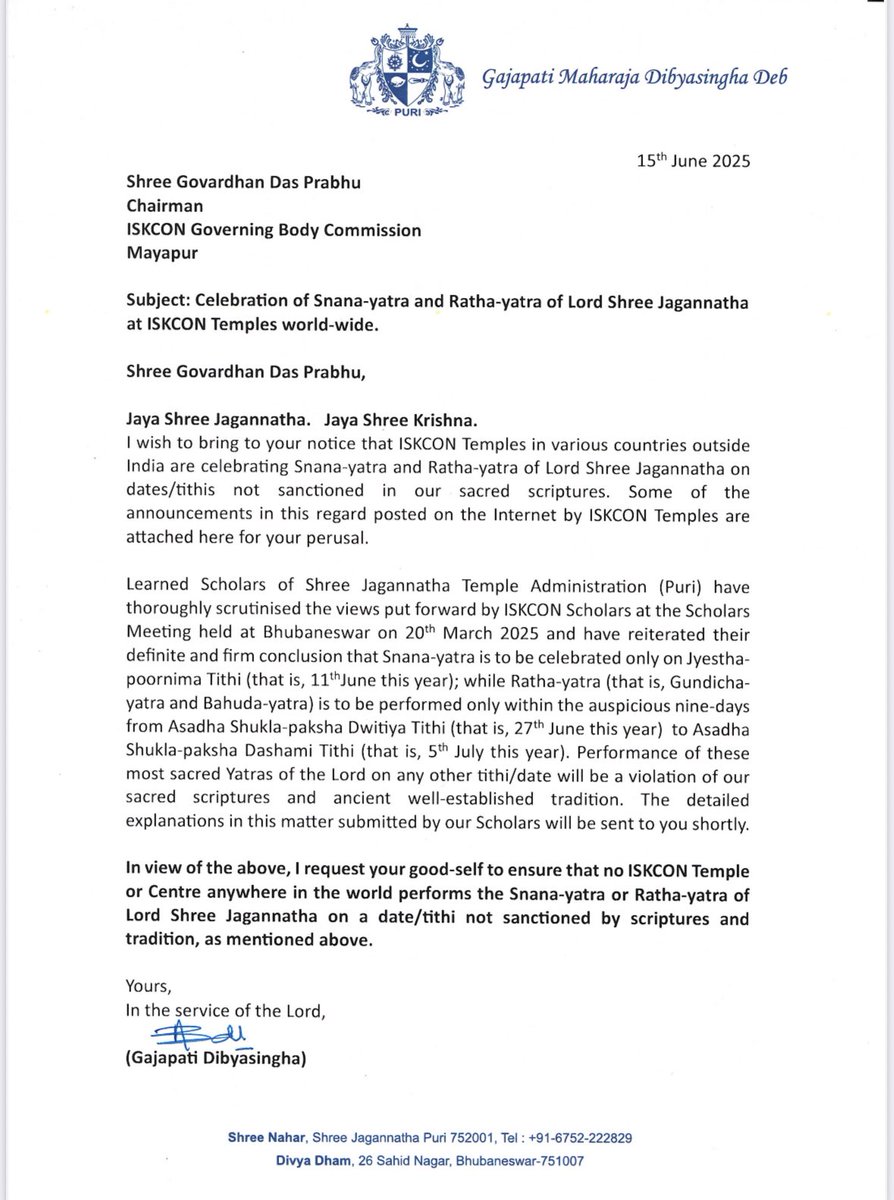Puri: A significant letter from Gajapati Maharaja Dibyasingha Deb, the venerable Chairman of the Shree Jagannatha Temple Managing Committee, to the Chairman of the ISKCON Governing Body Commission (GBC) Mayapur, Shree Govardhan Das Prabhu has brought to the forefront a sensitive issue concerning the precise observance of the annual Snana Jatra and Ratha Jatra festivals.
The communication, has been highlighted by Shree Jagannath Temple Administration Chief Administrator, Dr. Arabinda Kumar Padhee on X (formerly Twitter), emphasizes the critical importance of adhering to scripturally sanctioned dates and age-old traditions for these paramount events.
The Maharaja, who holds the esteemed position of ‘Adya Sevaka’ (first servitor) of Lord Jagannath, has expressed concern over apparent discrepancies in the calendrical calculations used by ISKCON for these major festivals, differing from those meticulously followed by the historic Puri temple.
Call for Uniformity in Sacred Observances
The Snana jatra, a ritual bathing ceremony for Lord Jagannath, Lord Balabhadra, and Devi Subhadra, traditionally occurs on the Purnima (full moon day) of the Jyeshtha month. This is followed by the deities’ period of seclusion (Anasara), leading up to the grand Ratha Jatra, which is celebrated on the second day of the bright fortnight of the Ashadha month (Ashadha Shukla Dwitiya).
These festivals are not merely religious ceremonies but are deeply embedded in the spiritual and cultural identity of Odisha and the global Vaishnava community. Their dates are determined by intricate Purnimanta and Amanta lunar calendars, guided by specific tithis (lunar days), nakshatras (constellations), and precise astronomical calculations, all codified in ancient scriptures and centuries of unbroken tradition.
“The Gajapati Maharaja, as the custodian of the Shree Jagannath traditions, is stressing the need for theological purity and authenticity in the observance of these sacred rituals,” a source close to the temple administration indicated, speaking on background about the sensitivity of the matter. “The precise timing is not just a detail; it’s fundamental to the spiritual efficacy and the continuity of our tradition.”
The Core of the Discrepancy
The Maharaja’s letter points to a divergence in the dates/tithis observed by ISKCON’s global centers compared to the traditional Puri calendar. This suggests that ISKCON, in its commendable efforts to propagate the Jagannath cult worldwide, might be utilizing alternative calendrical interpretations, resulting in a deviation from the established Purnima and Ashadha Shukla Dwitiya tithis that have historically governed the Puri rituals.
This issue is considered sensitive due to several key factors:
- Theological Purity: For devotees deeply rooted in traditional Jagannath culture, exact adherence to ritual timing is paramount, with deviations seen as potentially compromising the sanctity of the deities.
- Preserving Tradition: Any perceived departure from established practices, especially by a prominent global organization like ISKCON, raises concerns about the potential dilution of the original tradition.
- Devotee Unity: Discrepancies in festival dates can lead to confusion and disunity among the vast global community of Jagannath devotees.
- Astrological Accuracy: The determination of these dates relies on precise astronomical and astrological calculations, ensuring rituals occur at the most auspicious moments as per the Puri temple’s panchang.
A Call for Dialogue and Alignment
The Gajapati Maharaja’s communication is not framed as a rebuke but rather an earnest appeal for alignment and preservation. It underscores the pressing need for constructive dialogue between the Shree Jagannatha Temple Managing Committee and ISKCON leadership. The aim is to clarify calendrical differences and work towards a consensus that respects scriptural authority and the traditional astronomical calculations that have guided the Shree Jagannath Temple, Puri for centuries.
The ultimate objective, sources suggest, is a unified global observance of Snana Jatra and Ratha Jatra, aligning as closely as possible with the dates sanctioned by the Puri temple.
This, it is believed, will foster greater unity and authenticity in the widespread devotion to Lord Jagannath, ensuring these ancient festivals continue to be celebrated with the utmost reverence and scriptural fidelity across the world.


